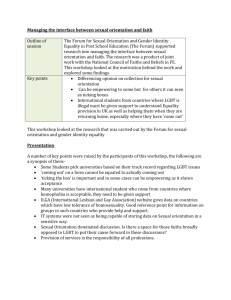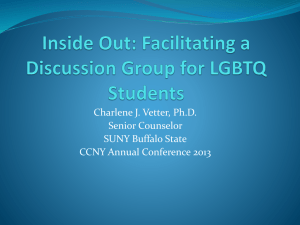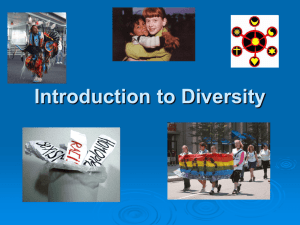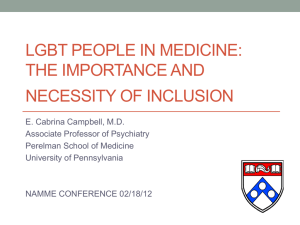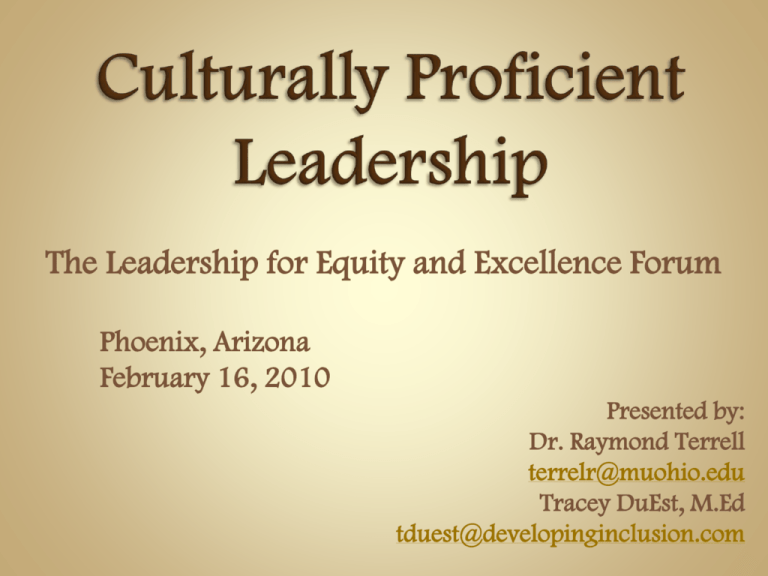
The Leadership for Equity and Excellence Forum
Phoenix, Arizona
February 16, 2010
Presented by:
Dr. Raymond Terrell
terrelr@muohio.edu
Tracey DuEst, M.Ed
tduest@developinginclusion.com
Stanford Ericksen said:
‘Students learn what they care about . . .,’ but Goethe knew
something else: In all things we learn only from those we love.
Add Emerson's declaration:
‘The secret of education lies in respecting the pupil,’ and we have a
formula that goes something like this:
‘Students learn what they care about, from people they care about
and who, they know, care about them . . .’
Thirty Years of Stories, 1996
Cultural
Proficiency as an educators’
personal work
Introduce
tools and strategies for
becoming culturally proficient
Linking the
work of educators’ cultural
proficiency to closing the achievement
gaps.
It is an inside-out approach
It is about being aware of how we
work with others
It is about being aware of how we
respond to those different from us
School leaders have to
do their own
work first.
Each leader
has to think deeply about
the guiding principles and essential
elements.
a journey with our colleagues, not
something done to them.
Cultural Proficiency is
We
begin where people are, not necessarily where we
would like them to be.
The Guiding Principles
Underlying values of the approach
The Continuum
Language for describing both healthy and non-productive
policies, practices and individual behaviors
The Essential Elements
Five behavioral standards for measuring, and planning for,
growth toward cultural proficiency
The Barriers
Three caveats that assist in responding effectively to resistance to
change
Not a single fixed thing
Multiple gaps based on (race, gender, language,
exceptionalities, other cultural factors)
Many data sources must be examined including:
test scores,
Discipline including suspensions and
expulsions,
gifted/advance class placements, and
special education placements.
7
The American education system is built on a Eurocentric, middle class, physically and mentally able
culture
The system works well for most students for whom it
was constructed
Built on a hierarchical culture
Competition is a cultural norm
Meritocracy is a cultural norm
Individualism is a cultural norm
Standard English is the basis for success in all areas of
the curriculum
In what ways do we adapt to students who
have a different culture, different set of
values, different behavior patterns, different
languages, and different learning styles?
9
Culture is a
predominant force
People are served in
varying degrees by the
dominant culture
Acknowledge group
identities
Diversity within cultures
is important
Respect unique cultural
needs
Cannot pick and choose
which cultures you value
The Guiding
Principles are the
core values, the
foundation upon
which the approach
is built
Cultural
destructiveness
Cultural incapacity
Cultural blindness
Cultural
pre-competence
Cultural competence
Cultural proficiency
There are six points
along the cultural
proficiency
continuum that
indicate unique ways
of perceiving and
responding to
differences.
Culturally Destructive… See the difference,
stomp it out…the elimination of other people’s
culture
Cultural Incapacity…See the difference, make
it wrong…belief in the superiority of one’s
culture and behaviors that dis-empowers
another’s culture
Cultural Blindness... See the difference, act like
you don’t…acting as if the differences we see do
not matter or not recognizing the differences
Cultural Pre-competence… See the difference,
respond inadequately…awareness of limitations of
individual and organizational ability to respond to
differences
Culturally Competent… See the difference,
understand the difference that difference makes.
Interacting with other cultural groups using the five
essential elements of cultural proficiency as the
standard for individual behavior and school practice
Advocacy for underrepresented
On-going education of self and others
See the differences and respond positively and
affirmatively esteeming culture, knowing how to
learn about individual and organizational culture,
and interacting effectively in a variety of cultural
environments, examples:
Make personal changes in attitudes and behavior
Develop alliances with members from other
cultural groups
Focus conversation on “we” and “us” not on
“them.”
Assess Culture
Value Diversity
Manage the
Dynamics of
Difference
Adapt to Diversity
Institutionalize
Cultural
Knowledge
The Essential Elements
of cultural proficiency
provide the standards
for individual behavior
and organizational
practices
Describe your own culture (Where folks lived, languages spoken,
work, foods, religion, and education)
Describe the culture of your organization (Classroom, school,
district)
Develop an understanding on how your culture and the culture of
your organization impacts those whose culture is different
Recognizing difference as diversity rather than an
inappropriate response to the environment
Accept that each culture finds some values and behaviors
more important than others
Seek opportunities to encourage and celebrate the
presence of a variety of cultures in all activities…my
challenge to you if you value diversity step outside yourself
for a moment and reflect on who you spend your spiritual
and leisure time with?
Diversity Wheel
Functional
Level/
Classification
Management
Status
Marital
Status
Geographic
Location
Work
Content/
Field
Income
Age
Parental
Status
Race
Personal
Habits
Gender
Personality
Union
Affiliation
Ethnicity
Sexual
Orientation
Appearance
Physical
Ability
Work
Experience
Internal Dimensions
Division/
Department
Unit/Group
Recreational
Habits
Religion
Educational
Background
Work
Location
External Dimensions
Organizational
Dimensions
Seniority
Source: Gardenswater and Rowe; adapted by
Lodan and Rosener, Workforce America.
Develop effective strategies to resolve conflicts,
particularly among people whose cultural backgrounds
and values are different
Develop an understanding of the effects that historic
distrust has on present day interactions
Realize that you may misjudge other’s action based on
learned expectations…recognize your own prejudices and
stereotypes
Change the way things are done to acknowledge the
differences that are present in staff, students and
community
Develop skills in cross cultural communications
Examine curricular materials and pedagogy to ensure
that cultural difference are equitably addressed
Use extra curricular activities as an opportunity to
increase the diversity interactions between and among
your students.
Teach the origins of prejudices and stereotypes
Incorporate cultural knowledge into the mainstream of
the organization by integrating staff development,
education, information and skills that enable all persons to
interact effectively in intercultural situations
There’s an elephant in the room
It is large and squatting, so it is hard to get around it.
Yet we squeeze by with, “How are you?” and “I’m fine,”
and a thousand other forms of trivial chatter. We talk
about the weather. We talk about work. We talk about
everything else, except the elephant in the room.
There’s an elephant in the room.
We all know it’s there. We are thinking about the elephant
as we talk together. It is constantly on our minds. For, you
see, it is a very large elephant. It has hurt us all. But we
don’t talk about the elephant in the room. Oh, please say
it’s name…race. Oh, please say it’s name culture, Oh,
please say its name, poverty, Oh, please say its name,
diversity Oh, please, let’s talk about the elephant in the
room.
For if we talk about its ills, perhaps we can talk about how
to set it right. Can I say its name to you and not have you
look away?
For if I cannot, then you are leaving me
ALONE
in a room
with an elephant
Schools nationwide are unsafe environments for a
distressing majority of LGBT students who continue to
face harassment and even physical assault, often
without intervention from school staff.
9 out of 10 students report hearing biased language
in their schools, most commonly anti- LGBT remarks.
Source: GLSEN National School Climate Survey 2007, Executive Summary
Nearly nine- tenths of students (86.2%) reported being
verbally harassed (e.g., called names or threatened) at school
because of their sexual orientation. And two- thirds (66.5%) of
students were verbally harassed because of their gender
expression.
Almost half (44.1%) of students had been physically harassed
(e.g., pushed or shoved) at school in the past year because of
their sexual orientation and three in ten students (30.4%)
because of their gender expression.
For some, victimization was even more severe – 22.1%
reported being physically assaulted (e.g., punched, kicked or
injured with a weapon) because of their sexual orientation and
14.2% because of their gender expression.
Source: GLSEN National School Climate Survey 2007, Executive Summary
The majority (60.8%) of students who were harassed or assaulted
in school did not report the incident to school staff, believing little
or no action would be taken or the situation could become worse if
reported. In fact, nearly a third (31.1%) of the students who did
report an incident said that school staff did nothing in response.
Source: GLSEN National School Climate Survey 2007, Executive Summary
Many LGBT students are forced to miss class or entire days of
school rather than face a hostile environment where they
experience continual harassment. These students are being
denied their right to an education.
31.7% of LGBT students missed a class because of feeling
unsafe, compared to only 5.5% of a national sample of
secondary school students.
32.7% of LGBT students missed a day of school because of
feeling unsafe, compared to only 4.5% of a national sample of
secondary school students.
Source: GLSEN National School Climate Survey 2007, Executive Summary
Students cannot succeed in school when they do not feel safe. The
incidence of in-school victimization experienced by LGBT students
hinders their academic success and educational aspirations.
Source: GLSEN National School Climate Survey 2007, Executive Summary
What are the top three issues that
students who have a different sexual
orientation are faced with?
Top three issues = harassment; “sin”; bias
Safe forum to deal with their feelings – both sexual feelings and feelings of acceptance in
a group.
Discrimination based on fear – that somehow the sexual orientation makes them sexually
deviant and a threat to other children.
Lack of role models in schools to help navigate the world from a position of
minority/oppression/difference.
Bullying/ teasing.
Having to keep secrets - trying to figure out who is "safe" to talk to (students and
teachers). At our school, there is an informal "underground network" of safe
people. We know who we are... I just hope all of the gay kids do, too.
They struggle to come out to their families and be accepted once they do, and then have
the same struggle with their peers and probably teachers too.
Some are teased for appearing too masculine or too feminine.
Prom, dating etc.
What are the top three concerns/fears that come up
for you, the district and/or the board when it comes
to dealing with sexual education?
The general community attitude toward LGBT is perceived to be discriminatory;
how do you approach a board that has several members who have known
religious fundamentalist views; will I lose my job if I advocate too strongly?
Ignorance in public perception that race/ethnicity and poverty are not choices for
people and homosexuality is – “they choose to be this way and they can choose
not to… they made their bed.”
Of the “isms” that we deal with in school, this is the only one that deals with
sexuality- we don’t talk about the sexuality of heterosexual students, so why do
we have to talk about sexuality at all? Keep it to yourself.
It remains a socially acceptable discrimination. It is okay to make gay jokes, make
fun of stereotypes, etc in social situations. People will and do still publicly
celebrate their homophobia. It feels unsafe for students to make it a public
event. How would we protect them from the public bashing that would be “ok”
in the eyes of many adults both in and out of school? It would never be okay to
go to a board meeting to say you did not want your children to go to school with
black children. I would venture to guess that it would be likely that there would
be people at a board meeting opposing support of openly gay students.
What if anything would make it easier for you to
deal with sexual orientation in your school district?
A friendly dialogue about the issues surrounding orientation with people of various
perspectives... not to change anyone's mind, but just to agree on what we can agree on
(for example, that bullying is wrong, no matter what you think about
homosexuality). We have done this with some student groups, but I never know if
the information really "sticks with them" after they leave the assembly... I'd love to try
a similar thing with a group of teachers, administrators, and Board members.
Board and community acceptance of LGBT; administrators in school buildings who
support LGBT; mandatory DISC training for everyone who serves our students.
With our GSA, I’m told by my administration we have to have parental permission to
show any videos and some of our members feel it difficult to disclose their
membership to their parents, even if their parents know they are gay it causes
difficulties when the issue is brought up. The videos are documentaries or interviews.
How do I comply with administration and expose my students to valuable videos
without causing problems on either front?
Tools, workshops etc., that can help school based teams with common language that
elevates the conversation beyond “sex”- relationships and feelings are so much more
than sex. We operate in ignorance. Knowledge is power.
If I knew what the district/building was willing to support and what they were
willing to try to eliminate.
The presence of Gay- Straight Alliances (GSA’s) can create a
more welcoming climate for LGBT students and allies.
Students in schools with a Gay-Straight Alliance:
Report hearing fewer homophobic remarks
Experienced less harassment and assault because of their
sexual orientation and gender expression
Were more likely to report incidents of harassment and
assault
Were less likely to feel unsafe because of their sexual
orientation or gender expression
Were less likely to miss school because of safety concerns
and reported a greater sense of belonging to their school
community
Source: GLSEN National School Climate Survey 2007, Executive Summary
Solution: Supportive Educators
Supportive Educators can make a critical difference in the lives of
LGBT students.
Students with supportive educators (six or more):
Were less likely to miss at least one day of school in the past
month because of safety reasons (20.4%) than students with
no supportive educators (39.8%)
Had higher GPA’s than students without supportive
educators (2.9 versus 2.5)
Reported higher educational aspirations than those without
supportive educators
Reported a greater sense of belonging to their school
community than those without supportive educators
Source: GLSEN National School Climate Survey 2007, Executive Summary
Only 16 states and the District of Columbia (green and magenta in
the map below) have safe schools laws designed to protect students
based on sexual orientation.
Only 12 states
and D.C. (green
in the map) have
such laws to
protect students
based on sexual
orientation and
gender identity/
expression.
Source: GLSEN National School Climate
Survey 2007, Executive Summary
The first type is non- discrimination laws
which many states have passed to provide
protection from discrimination to LGBT students
in schools.
The second type is fully enumerated antibullying laws. These are laws that specifically
prohibit bullying and harassment of students
based on sexual orientation and gender
identity/ expression.
Source: GLSEN National School Climate Survey 2007, Executive Summary
School policies that directly address anti-LGBT bullying and
harassment can create better learning environments for LGBT
students:
Students heard fewer homophobic remarks (68.8% frequently
or often) compared to students in schools with generic, nonenumerated policies (74.3%) or no policy (75.0%)
Students experienced lower levels of victimization related to
their sexual orientation than students with generic policies or
no policies at all
Students were more likely to report that school staff intervened
most of the time or always when hearing homophobic
language in school (29.1%) compared to students in schools
with generic policies (17.5%) or no policies (13.1%)
Source: GLSEN National School Climate Survey 2007, Executive Summary
. . . , listening . . . requires not only open eyes
and ears, but open hearts and minds. We do not really
see through our eyes or hear through our ears, but
through our beliefs. . . . It is not easy, but it is the only
way to learn what it might feel like to be someone else
and the only way to start the dialogue.
- Lisa Delpit
38

